
Thomas Eakins, photography (Man on ladder with dissected horse leg, 1880, Glass negative.)
“Sociology is rarely more akin to social psychoanalysis than when it confronts an object like taste, one of the most vital stakes in the struggles fought in the field of the dominant class and the field of cultural production. ”
Pierre Bourdieu (A Social Critique of the Judgement of Taste)
“No audience. No echo. That’s part of one’s death.”
Virginia Woolf (Diaries)
“Once we have taken Evil into ourselves, it no longer insists that we believe in it.”
Franz Kafka (The the Zürau Aphorisms)
“Why did we pursue it? Because it was impossible.”
Herbert Blau (The Dubious Spectacle)
“Human cultures are about place: where to live, and home: how to live and with whom. In Western capitalist culture, home is where the money is. And place, increasingly, is an abstraction.”
Curtis White (Living in a World that Can’t Be Fixed)
There seems to be a common and shared realization right now, in what one used to call the zeitgeist. The realization in its most general sense is about the evisceration of culture. Both global culture, and specifically U.S. culture, and by extension European culture. The realization is widespread but it is still a minority position. But clearly many are feeling this. And I can feel there is a common thread having to do with the loss of language, and with how internet technology has encouraged conformity and fear. And that this destruction of culture, in the broadest sense, is resulting in new levels of incoherence. Not just incoherent leaders, or public figures, but incoherence in a deeper almost metaphysical sense. There are innumerable critics writing from a myriad of perspectives but all coming to, relatively, the same conclusions.
The loss of language skills is the foundation on which many other problems develop. Simon Elmer has a cogent interview about (mostly) smartphones. https://realitycheck.radio/replay/simon-elmer-author-and-co-founder-of-architects-for-social-housing-on-why-we-should-destroy-our-smartphones-now/
One of his observations is how this dependency on smartphones has inculcated the sense of inadequacy in people. I think this is correct but I think the loss of language skills (even the loss of cursive writing skills) has done the same, earlier, and perhaps allowed for an easier transition to this learned helplessness of smartphone addiction. But none of this would have the traction it has if the political system in which most of the world lives were not reaching a state of crisis. Capitalism repeatedly arrives at crises, but this feels like the mother of all crises. This crisis also feels at least partly intentional. Western capital has decided to contract. This is not, I don’t think anyway, a complete consensus, but it was the decision of most of the billionaire class in the West. I also wish Elmer had avoided the word *totalitarian* (and Arendt) but perhaps I am being picky.

Laureana Toledo, photography.
“It is in this sense, I believe, that we should understand the statement made by every Western government and transnational technocracy from the United Nations down that they stand with Ukraine ‘for as long as it takes’. The victory they have their eyes on is not over Russia but over their own people, the immiseration and control of which is the ultimate goal of the Great Reset.”
Simon Elmer (For As Long as it Takes, Architects for Social Housing, March 2024)
There is also a concerted effort by the government, and Silicon Valley, and WEF, to sort of phase out long form reading. Discourage laptop usage and replace it with smartphone use. Reading on computers is hard enough but its impossible to read long dense articles and books on smartphones. Google search is now a kind of exquisite corpse machine and not really a research tool. Google calls it a companion and not a research tool.
Western society is lurching toward a state of cultural solipsism. Gen Solip. Thinking is now so fragmented as to not actually qualify as thought. Gen Solip or Gen Deep Fake. When even the White House press secretary uses ‘deep fakes’ as an alibi, then public discourse has reached some sort of threshold. And my interest is not so much in repeating the obvious facts of what the pandemic protocols achieved (others have done this quite well) and the Great Reset. I want to better understand the evolution of meaning in society today and how and why it has landed in total fascism.
“The exodus from cities to suburbs after World War II began one of the most significant demographic shifts in American his- tory and was a reaffirmation of the American dream in concrete, commercial terms. The ideal of the freestanding single- family dwelling with lawn, carport, and a bedroom for everyone came, by virtue of ingenious community planning, energetic marketing, and the GI bill, within range for a larger number of families than ever before. Experimental communities such as Kaiserville in the West and Levittown in the East carried in their blueprints not only a new set of practical possibilities but a set of values keyed to a new kind of consumerism. Homes were affordable and available. Things to fill those homes were multiplying at a staggering rate. Sears catalogs, Tupperware parties, and Chevrolets became visible indices of comfort, stability, and success.”
Marilyn R. Chandler (Dwelling in the Text)

Michael Kvium
I grew up in the 1950s. I graduated high school in the 69, the summer of love. The writers of suburbia, Cheever and Updike, but also Ford, Yates, John Barth and Raymond Carver. In fact American fiction, since WW2 has largely been a fiction of the suburbs.
“None of these stories is sentimental—indeed, the sentimentalities of the protagonists in each are exposed as just as much a sham as the false values motivating those who threaten their pieties. All the stories are both ironic and ambivalent in presenting the spread of suburbs, rectilinear streets, shopping malls, and chrome and glass kitchens as an outgrowth of a complex of needs and values that are not all bad. In the tradition of the jeremiads that characterize our literary tradition, these stories are warnings but not condemnations. As a culture still firmly grounded in our Puritan foundations, we are uncomfortable with our own hard-won comforts. Moreover, our romantic legacy makes us wary of possessions and practices that separate us from nature; we tend in many ways to harbor the same distrust of “civilization” that drove Thoreau out to Walden Pond and caused Huck Finn to “light out for the territory.” What each of these writers does, like many others of their generation, is to reassert the continuity of the pervasive social and metaphysical concerns that have most distinctively characterized our native tradition, bound as it has been to a history of settlement and conquest whose morally ambiguous victories have left each generation uneasily contemplating the cost of its own achievements.”
Marilyn R. Chandler (Ibid)
This is primarily, though not exclusively, a white literature. And when one looks back over this work, which stretches from the early 1950s to maybe the mid 70s, there is a prescient focus on loneliness. On disappointment and loneliness. The point here is that what Chandler describes as the American distrust of civilzation and the grounding in Puritanism, is also an indelible racism and a distrust of intellectuals and of culture. Suburbia was the warehousing of the working class (in the U.S. they see that as ‘middle class’). And the dreams that were, briefly, associated with this ideal (always more an idea than a reality) evaporated within a decade.

Alex Majoli, photography.
“Indeed, what the current revolution from neoliberalism into biosecurity is demonstrating is that, far from being opposed to fascism — as it has depicted itself in the culture wars of the past twenty years — woke, with its cult of youth, its saccharine sentimentality, its suppression of memory, its embrace of mob rule, its kitsch aesthetics, its regression to cultural conservatism, its adherence to identity politics, its hatred of the working class, its allegiance to the market as the only framework for change, its addiction to surveillance technology, its extolling of reform over revolution, its suppression of intellectual, cultural and political debate, its normalisation of censorship as the default response to disagreement, its culture of no-platforming those who do not share its principles, its ban on books and authors that do not adhere to its ideology, its organised campaigns to socially ostracise and professionally ruin the uncompliant, the violence with which it demands allegiance to its orthodoxies, the adolescent puritanism of its sexual politics, its creation of ideological hegemony through indoctrination programmes such as ‘diversity training’, its hierarchy of obedience established by public demonstrations of virtue, its almost universal adoption by our media, police forces, education and cultural institutions, its enforcement by repressive legislation removing our rights and freedoms on the justification of protecting us from the heterogeneous elements of society, and above all the ease with which it has been employed by national governments, international corporations and the global technocracy they form to increase and expand their political, economic and cultural power — in short, by its facilitation of capitalism’s construction of the totalitarianism of the global biosecurity state — woke is not liberal, and it certainly isn’t socialist: woke is fascist.”
Simon Elmer (From Kitsch to Woke: The Aesthetics of Totalitarianism )
This pretty aptly describes the state of the current true believer in the West. What interests me is the way in which this fascist sensibility has survived since WW2. Fascism was never defeated, it migrated and went into hiding. Fascism was there, certainly, in suburbia.
“At the time I stopped my theater work, after more than thirty-five years of it, I wrote a book on the activating pretense (or enabling fantasy) that what, in the last phase of that work especially, had been happening on the stage was continuing on the page: a certain elliptical and circuitous density of performance, whose energy came from an obsession with disappearance, or the forms of disappearance, now you see it now you don’t, the ghostliness of the referent, it all, it all, as Beckett might say, encapsulating thus the unspeakable whole truth of its fatal attraction—whatever it might be. So far as I understand that obsession, it arose from the grounds of impossibility out of unabating desire, in theater, now theory, to get as close to the thought of theater as theater would be if it were thinking about itself, crossing the critical gamut and teasing us out of thought.”
Herbert Blau (The Dubious Spectacle)
Now, I want to return to Herbert Blau here, which entails a bit of a detour, but which, trust me, is hugely pertinent.
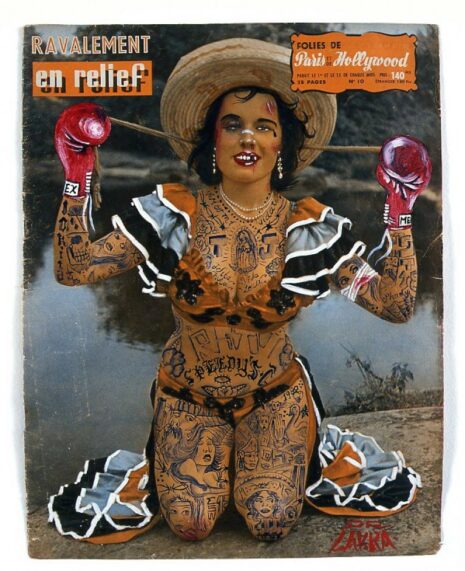
Dr. Lakra
I spoke in the first lecture about religion coming out of theatre. And sure enough, I find Blau shares a similar thought.
“That there is something other than theater, prior to it, by whatever name—life, reality, manifestations of social process or relations of production—is not in itself a foregone conclusion (no more than the staple of theater history that theater is derived from ritual instead of, possibly, the other way around).”
Herbert Blau (Ibid)
In this era of deep fakes and instant image manipulation the idea of authentic becomes contested. As Blau notes, in fashion (which he takes rather more seriously than one might imagine) there are representations of ‘naturalness’ (this is true in film acting, too). It is the affect of naturalness, rather than actual naturalness. For today, what IS actual naturalness? So the artifice must suggest something of a core authenticity behind the facade (all is a mask). The artifice must contain elements (or affects, or effects) that register as ‘real’. And real means, I think, non manipulative. But all is manipulative, so the effect is to appear without manipulation even though everyone knows it is manipulated.
Blau wrote The Dubious Spectacle in 2002 (though some of the essays are from decades earlier). Blau anticipates the cultural crisis of today. And he convincingly sees Beckett and Genet as prophets. What this gradual erosion of literacy, of language skills altogether, and the advent of the internet and smartphones has meant is (firstly?) the loss of an audience.

Dimitry Markov, photography.
“The subtitle of the book also accounts for the title of this essay, whose subtitle—“Theater at the End of the Real”—will have more or less reality depending on your perspective or, for that matter, your critical view of perspective with its notorious vanishing point. For there we encounter the liability, even the vice, of representation, implicating the theater in the recessive economy of mystification that, according to much recent theory, supports the imperious logic of advancing capitalism, as if it came with the bourgeois enlightenment out of the blinded sockets of Oedipus’s eyes as formed in Plato’s Cave. { } Or it is possible to think, as it is now being thought, that where the real has ended the spectacle begins or that the commodification of the spectacle is the end of the real. Whatever the case may be, as distinguished from the real, the case is defined by the interaction of theater and the phenomena of photography, which from its foundational moment, by a man of the theater, was also obsessed with disappearance.”
Herbert Blau (Ibid)
Barthes suggested that portrait photography always showed something of a funereal mask (especially in fashion) behind which one perceived the dead. Photographic portraits are paradoxically more like morticians studies than painted portraits. The frightening part of death is disappearance. Ceasing to appear. Theatre is the ur-medium because for it to exist it must be watched. Another reason the single character play never quite feels like theatre. The relationship of the single performer with his or her audience is different than that of an ensemble. The ensemble (even of two) is impersonal. Preacher or professors are always personal.

Joyce Pensato
Henri Leroi Gourhan (Gesture and Speech)
So, at a point where humanity has lived with photographic technology for over a hundred years, and mass reproduction tech for sixty, and digital tech for, what? For forty say… then ideas of what is natural are going to be difficult to even formulate. The very construction of a concept like ‘natural’ is meaningless, today. We’ve lived for sixty years, or more, with organized advertising. With corporations devoted to marketing and manipulation of image and frame. But certainly over the last fifteen years, or perhaps twenty, there has been, clearly, some kind of ruling class project to dispossess and pauperize the proletariat. The world is more proletarian than ever, but part of this project has been to erase such facts. History is being erased and very effectively so — loss of language and by extension curiosity — means a good many people today simply know almost no history at all. And if they know any, its almost always revisionist.
“Psychology describes the phenomena of seeing.–For whom does it describe them? What ignorance can this description eliminate?”
Ludwig Wittgenstein (Remarks on Colour)
“ideology emerges within performance, not outside it.”
Herbert Blau (To All Appearances)

Joshua Reynolds (Georgiana,Duchess of Devonshire with her infant daughter. 1784)
The question here, then, is the ascendence of performance into all aspects of daily life. Maria Minich Brewer writes…” the concern that the migration of performance to other disciplines and the “theatricalizing of daily life” deprive their discourses and practices of specificity, making them increasingly unavailable for theater studies. How, he asks, given the new hegemony of performance, can theater resist the reproduction and commodification of the image that is occurring on a global scale? Will the economy of reproduction, with “image consuming image,” succeed in relentlessly and totally recuperating the very concepts and inventions designed to describe and critique it? “
(The Thought of Performance”: Theatricality, Reference, and Memory in Herbert Blau)
This migration of performance means, too, then, if Blau is correct, that ideology now permeates daily life. One might ask if it hasn’t always, but I think certainly not in the way being addressed. Blau suggested that one answer to the problems of culture, of theatre in particular, is to make less of it. Its odd because I said something very similar in the very first (audio only) podcast during my last visit to LA. I said artists are now, theatre artists, a bit like those desert monks, the Desert Fathers, who ventured out into the wilderness, as it were, to protect the tomes and practices of early Christianity. One cannot beat the global machine on its own terms.
“Blau formulates the idea of a “resistant theater,” which, through an “ontology of disappearance,” resists the double bind operating between performance and ideology. Such an ontology of disappearance, the making of less theater, is conceived as a problem of repeating “the thing that always escapes you, the still inarticulable substance of theater: its resistance as disappearance, pursued as theatrical fact.”
Maria Minich Brewer (Ibid)
This has far ranging implications. Now I have written about Blau a couple times on this blog.
https://john-steppling.com/2016/09/the-audience-appears/
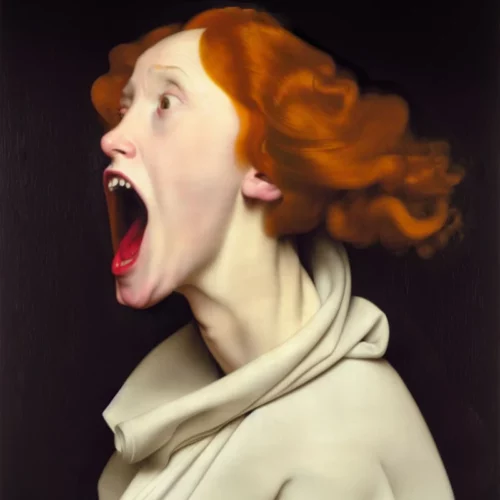
Wolf Von Lenkiewicz
This is what intrigues me, finally. The fact that theatre is always disappearing. Blau wanted to reclaim something of the formal relationship to text. For the ideology of performance becomes the performance of ideology — mass culture, the Spectacle, is in the business of dispersing and neutralizing this sense of the formal. Beckett looms as among the last playwrights to create with a philosophical voice. Handke does too, and Bernhard. Brewer quotes Adorno…
“Theodor Adorno who, in Philosophy of Modern Music, writes of a collectivity that is “necessarily degraded almost to a fiction—to the arrogance of the aesthetic subject, which says ‘we,’ while in reality it is only ‘I’—and this ‘I’ can say nothing at all without positing the ‘we.”
Maria Minich Brewer (Ibid)
Besides being funny, this segues the discussion to the audience. And one of the problems with the idea of *audience* is the missing element of class. Again, this is 2024, not 1995. And not 1965. Today’s audiences, or those who are potential audiences, has to do the severity of class restrictions today. Prestige theatre companies like The Wooster Group are not exactly easy to access. The audience is affluent. Maybe more. Open the NYTimes to read some theatre reviews. Look at what is playing in the city. Look at the names of the artistic directors of America’s biggest theatres. Regional and in NY. LA doesnt even have a flagship theatre anymore. The Taper closed. Run into the ground by the middle brow woke fascists (per Elmer) and a kind of elitism that feels almost nostalgic, it is so out of touch. The Wooster Group, as I randomly open a page of earlier productions, using movie stars often enough. Stars who need ‘art’ cred (Francis McDormand, wife of millionaire director Joel Coen for example, whose filmography includes the reprehensible Nomadland.) This is not to pick on the Wooster Group (well, not particularly) but like McDormand they traffic in an ersatz seriousness. And they reinforce the aesthetic status quo almost obsessionally. It is worth noting that McDormand and Denzel Washington (who I often think is good) starred in the Joel Coen directed version of Macbeth. The ways in which this was appallingly bad are worth an entire blog post, but suffice it to say the film will be the standard for how not to film Shakespeare. A double bill with Welles version would prove instructive (Micheál Mac Liammóir who played Iago to Welles Othello reminds me curiously of Alan Cumming…but I digress). The opening of Welles version was not in the play. Its the funeral of Othello. One might mistake this for Bergman, meaning Bergman had watched quite a bit of Welles.

The 7th Seal (Dr. Ingmar Bergman,. 1957. Final shot)
The opening of Joel Coen’s Macbeth mostly follows the play. But immediately there is the problem of language. One reviewer put it, ‘Washington humanizes Shakespeare’s language’. This is the philistine idea of ‘relateability’. Shakespeare wrote poetry. This segues back to naturalism again. Shakespeare is not writing everyday speech. And in fact even many good productions of Macbeth, with notable actors, struggle with this idea. Watch Peter Brook’s King Lear with Paul Schofield. This is almost surreal in some respects, but Schofield is manifesting an interior world — one of originary space, the primal scene. One can find the scene of Lear’s banishing of Cordelia on youtube. Watch it.
Then close your eyes and listen to it again. To Schofield. What is he doing different than Washington, say? This is very hard to explain in a sense because it has to do with the almost subliminal framing (from Schofield as well as Brook). By which I mean Schofield speaks not naturalistically, but he also privileges the language. In a sense there is a distance created between actor and Shakespeare’s text. Watch another youtube clip titled King Lear (1971) Directed by Peter Brook CLIP #10. It’s hypnotic. But it can also be viewed as highly artificial. The text is the focus. It is almost the ‘dehumanizing’ of the language.

The Tragedy of Othello (dr. Orson Welles 1951. Opening scene).
There is a 1995 version of Othello, directed by Oliver Parker with Laurence Fishburne and Kenneth Branagh. Its very bad, sadly, but mostly because of Parker. Its borderline kitsch in fact. There are others, the Polanski version, which is intentionally kitsch though in a rather intelligent way. I wrote on Shakespeare productions earlier on this blog.
https://john-steppling.com/2016/01/macbethmachine/
In it I quote Adorno (Aesthetic Theory) “How can making bring into appearance what is not the result of making; how can what according to its own concept is not true nevertheless be true? This is conceivable only if content is distinct from semblance, through the form of that semblance. Central to aesthetics therefore is the redemption of semblance; and the emphatic right of art, the legitimation of its truth, depends on this redemption?”
In my earlier post I wrote about the 2016 Macbeth, directed by Justin Kurzel, starring Michael Fassbinder. It is worth reading I think (if I say so myself) because much of what I said about Kurzel’s film can be said about Coen’s.
“Aesthetic illusion is not an appendage of an artwork, as if an artwork presented itself as something and also evoked or provided an illusion to accompany itself, but is rather its very mode of existence. Illusion is the defining characteristic of artworks. An artwork is an artwork just so far as it pretends to be something which it is not. But what is it that artworks pretend to be? In answering this question, all discussions of art as representational, or artworks as symbolizing or referring, fall by the wayside; what artworks pretend to be are coherent, meaningful, unified wholes-in a word, they pretend to being-in-itself. The illusion of art is that it is non-artifactual. The illusory quality of art conceals the artwork’s material, historical production.”
Tom Huhn (Adorno’s Aesthetics of Illusion, Journal of Aesthetics and Art Criticism, 1985)
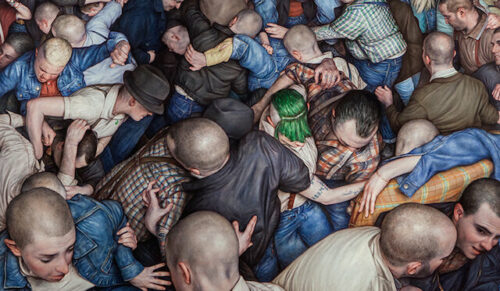
Dan Witz
“Still, the essence of meaning is not synonymous with illusion; it is more. Above all, the meaning of a work of art is also the summoning to appearance of an essence that is otherwise hidden in empirical reality.”
Theodor Adorno (Aesthetic Theory)
Contemporary film, and perhaps all contemporary visual art, suffers from a denial of the spiritual (as Adorno defines it anyway). It denies the illusion. It is a bit of a nudge nudge wink wink kind of thing. I quote Kantor, too, in that blog post:
“I believe that an artwork has to be closed if it is to fascinate. A closed artwork forces the viewers to focus. They’re forced to feel like people in the shadow of a huge pyramid, which is inaccessible but has a colossal, not to say metaphysical, influence. However, this pyramid emanates certain vibes.”
I think everyone instinctively knows the truth of this, feels the truth of it. And it is not unlike Kafka’s Castle. And these ‘things’, in a landscape, conjure our unconscious sense of primal space.
Adorno noted that performance art (and ‘happenings’) are firstly just bad art, but also a pernicious defense of naturalism. And in this context naturalism is the status quo. It is also a kind of anti-intellectualism, and infantilism. It is a subtle diminishing of the artists confrontation with illusion. It is (per Thomas Huhn) an ‘aesthetic literalness’. And these tendencies in contemporary culture can be traced back to the Nazi’s definitions of ‘degenerate art’. For what was desired was exactly ‘aesthetic literalness’. And this is also a part definition of kitsch. Authentic art creates an apparition of something not made. Not directly anyway. This is again the spiritual. But kitsch spirituality is very widespread. In the case of bad Shakespeare interpretations the aesthetic violence against that which is not made is almost palpable. Francis McDormand’s performance as Lady Macbeth is almost Monty Pythonesque.

Jonathan Wateridge
The loss of any oppositional practice to the familiar (kitsch) has resulted in this middle brow (I am reminded of Curtis White’s Middle Mind here) bourgeois conceit that collects the trappings and decor of seriousness and parades them as signifiers of prestige, and more, of virtue. The audience for Joel Coen’s Macbeth are well aware of how they should feel watching this ultra-prestige project. It is virtuous to appreciate the designated excellence. (one amusing and telling side bar was the review on the Roger Ebert site by Odie Henderson….’My high school senior year English teacher, Mr. Kilinski would be proud that I remembered every single stanza and line from Macbeth he made his students memorize. As Denzel Washington, Frances McDormand, and others worked through the Bard’s words as adapted by director Joel Coen, I felt myself lip-syncing under my mask.’) But this phillistinism is tied directly to this crypto fascist sensibility.There is an industry that reports on (under guise of criticism) on cultural consumption. Social media is awash in these exercises in banality. The continuous alteration of even dictionary definitions — where wrongly used words are then rendered acceptable because they have been used wrongly for so long– is another example of this trend toward dilution. Under cover of an anti-elitism argument, what happens is the undermining of learning. (props to Richard Brody at The New Yorker for spotting the fraudulence immediately).
Here is an interesting sidebar to these topics https://gaiusbaltar.substack.com/p/the-problem-with-mind-control-not?utm_source=post-banner&utm_medium=web&utm_campaign=posts-open-in-app&triedRedirect=true
The degeneration of art and culture is also a primary driver of mental health issues. Or rather, it has contributed to the institutional response to and treatment of ‘mental health issues’. As the above article suggests there is also a technological overload. This is not a new concept but it does update the issue nicely. But let me return to Adorno on aesthetics…
“The second sort of objectification is that which we have already discussed as being immanent to the artwork’s unfolding.This latter sort of objectification is an echo of the former. What prohibits this echo from achieving a complete objectification of the artwork is the existence and negative thrust of spirit within the artwork. We ought now to confront the schizophrenic core of spirit’s life. The schizophrenia comes to the fore when we consider Adorno’s remark that spiritualization is itself a kind of domination. This characterization flies in the face of the exposition of spirit we have just presented. We have until now understood spirit as the vital force which comes to be through a particular configuration of appearing qualities in the artwork. Now we must attempt to see spirit as not just a product of these qualities but also as a force which congeals particular moments of an artwork into a whole. That is, we must come to see active spirit as the instrument of objectification in the artwork. Further, spirit achieves this objectification through a domination of the artwork’s aspects that is modelled on the social domination of nature. Spirit, we might say, is the master of what we referred to above as the second sort of objectification. Spirit is the agent which effects the transition, indeed trans- figuration, of appearance into objectification.”
Tom Huhn (Ibid)
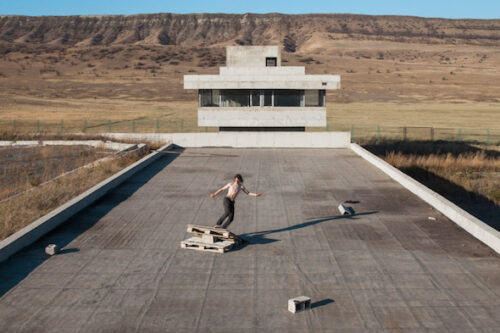
David Meskhi, photography.
In a sense I am saying that discernment and taste allow for a richer interior narration, a deeper spiritual (if you will) experience with artworks. That the truncated superficial kitsch from Hollywood (and elsewhere) is part of a system of cues and codes that reinforce authoritarian systems, and more significantly interrupt internal reflection and memory. This interruption, and I’ve written on this before, in the form of commercial interruption, or just structural incompleteness, are both unconsciously frustrating but also encourage the simplistic rewards of jingoistic kitsch. In a society that has stopped reading it is hard to imagine exactly how to correct this.
“The correct analysis of spirit’s schizophrenic activity revolves around spirit’s schizophrenic pre-history. Spirit’s pre-history occurs in objectification. The potential for emancipation of the objectified world resides within the very same objectified world. This is due to the necessarily incomplete nature of the process of objectification. Nothing is fully objectified, or put differently, anything that is fully objectified retains within it an unfulfilled or unexpressed appearance. It is these uncompleted appearing qualities which spirit emancipates as negation of their objectifying enslavers. The spiritual activity of redeeming these concealed qualities of objects takes place as art. “
Tom Huhn (Ibid)
That which is there as spirit, that apparition which appears but it not directly made, is the vehicle for redemption, for recuperation of the spiritual. Adorno also says its the truth of the artwork
.
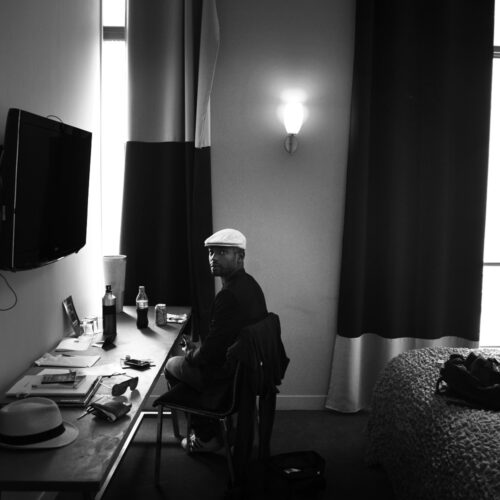
Nicolo Lo Calzo, photography.
“The language of expression is older than its significative counterpart; it is also un- redeemed. It is as if artworks were re-enacting the process through which the subject comes painfully into being …. Art possesses expression not when it conveys subjectivity, but when it reverberates with the primal history of subectivity and ensoulment.” Although Adorno has it that expression has no content, he nonetheless states that expression is always expression of suffering-which coincides with his statement above regarding artworks as the recapitulation of the painful birthing of subjectivity. “
Tom Huhn (Ibid)
This is the heart of the matter in a sense. Theatre, as I use the term, IS subjectivity in a sense. Not for toucans or hermit crabs or even gorillas, but for man, it is. The article linked above about ADHD and students on screens etc, begs one of two important questions.
“Wherever the unconscious is, it is a scene of theatre.”
Herbert Blau (Ibid)
And I would add, wherever there is a scene of theatre , there is the scene of a crime.

Paul Fryer
The questions begged by that article are really not questions per se. It is more that it is guilty (not that I think the article is not good or useful in its way) of what it is trying to correct. As soon there is an attempt to measure something like *attention* one is confronted with a host of problems. Consciousness remains incredibly obscure, incredibly hard to define and describe. This is why I go on at such length about early humans, theatre, ritual, and the formation of the human psyche. Wittgenstein is predictably very useful in such contexts. But these problems, things such as ADHD, are tied into aesthetics and religion and psychoanalysis far more than they are to be handed over to kitsch science. The idea of theatre as the ur-experience of space –neither internal nor external, and then of identity, based on walking (sic) across this space, as a precondition for being seen, is much closer to Medieval mystics than to neuroscience. I was reminded of The Cloud of Unknowing, a 14th century book on prayer, or instruction for meditative contemplation, by a monk ( Carthusian, or not, or a hermit, or country parson etc). The England of the 14th century produced numerous religious writers of distinction, starting with Julian of Norwich and Richard Rolle. In Europe there was Thomas a Kempis and Meister Eckhart and Catherine of Siena. The Black Death ravaged the continent, as did the Hundred Years War, and the English peasants revolts.
Here are the opening lines:
“I charge and beg you, with all the strength and power that love can bring to bear, that whoever you may be who possess carrying it, this book (perhaps you own it, or are keeping it, or borrowing it) you should, quite freely and of set purpose, neither read, write, or mention it to anyone, nor allow it to be read, written, or mentioned by anyone unless that person is in your judgement really and wholly determined to follow Christ perfectly. And to follow him not only in the active life, but to the utmost height of the contemplative life that is possible for a perfect soul in a mortal body to attain by the grace of God. And he should be, in your estimation, one who has for a long time been doing all that he can to come to the contemplative life by virtue of his active life. “
The Cloud of Unknowing
In a sense, make less theatre.

Melissa Meyer
I am coming to see more and more often the problems of capitalist science today. The draining away of philosophy and reflection. Adorno’s belief in the redemptive potential of modernism, of aesthetics in general, must bring one close to philosophy, and then logically religion or mysticism. And to the recreating of community.
There is no audience. Or rather, the audience has gone elsewhere. The audience IS elsewhere. Even as a concept or ideal, the audience is now shrouded in a kind of techno-caul, which metaphor suggests the reality of permanent incompleteness, or of a never-to-be-born silence. The audience is a demographic to be captured. It is a statistical category. And we are entering the time of shifting collective presentation of the group.
“Freud references the character of the pale criminal from the work of Nietsche in the discourses of Zarathustra when explaining that the pale criminal’s act is the externalisation of unconscious guilt and the desire for punishment that goes along with it (Freud 1916). This guilt, he says, “is derived from the Oedipus complex and was a reaction to the two great criminal intentions of killing the father and having sexual relations with the mother” (Freud 1916).This sense of guilt is derived from the tension between the harsh super ego and the ego that is subjected to it, and expresses itself as a need for punishment.”
Brendan Dolan (Oedipal Guilt, Punishment, and Criminal Behavior)
Perhaps the real damage of screen habituation is less in the technology and more in the interupptions to healthy psychic maturing.
“Among the young people that I encounter in my work the father is rarely present in the subjects life in terms of fulfilling the role necessary for the completion of the Oedipus complex. Neubauer (1960) makes a point that is very pertinent to the subject matter of this paper. He says “the intense and persistent attachments to a fantasied father which these children constructed out of even the most meagre relationships to any man, or even in the absence of any father at all… seem to indicate the children in the Oedipal phase are compelled to create in fantasy what does not exist in fact” (Neubauer,1960) The men who are created in such fantasies tended to extremely idealised or endowed with terribly sadistic traits.(Miler, 2003) It appears that in the absence of a real father the fantasy fathers that are created in the children are more draconian that any real father. If we follow the logic that the identification with the father is internalised and the sadistic attributes of this fantasy father become central to the formation of the superego, then the implication is that the child will continue to be subject to it’s sadism.”
Brendan Dolan (Ibid)
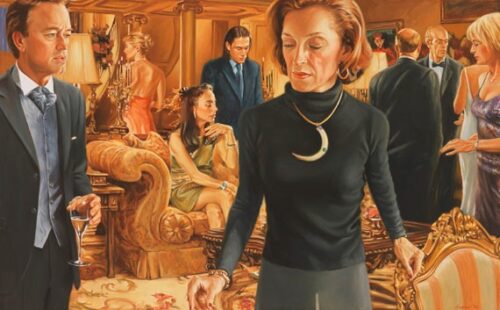
Terry Rodgers
“What is this man? A mass of diseases that reach out into the world through the spirit; there they seek their quarry. What is this man? A coil of wild serpents that are seldom at peace among themselves–so each goes forth separately and seeks its quarry in the world. Look at that poor body! What it suffered and craved, the poor soul interpreted for itself–it interpreted it as murderous desire, and a craving for the happiness of the knife.”
Friedrich Nietzsche (Also sprach Zarathustra)
In the amnesia of 21st century capitalist society there resides the horrors of revanchist fascism. The giant hole of forgetting, the forgetting, it seems, of even how to read and write. Replaced by primitive punching images on screens, and the neurotic compulsive touching (every 22 seconds) of the gadget totem, the anxiety machine, is what stares back at man today. Himself or herself but not. An other, but not. There is no crime without the law. And society keeps writing new laws. Expanding the power of policing. Israel commits genocide but its private security team (ex IDF) are hired to police the streets of Los Angeles. This is the most savage of super egos today.
“Walking Around”
“It so happens I am sick of being a man.
And it happens that I walk into tailorshops and movie houses
dried up, waterproof, like a swan made of felt
steering my way in a water of wombs and ashes.
The smell of barbershops makes me break into hoarse sobs.
The only thing I want is to lie still like stones or wool.
The only thing I want is to see no more stores, no gardens,
no more goods, no spectacles, no elevators.
It so happens I am sick of my feet and my nails
and my hair and my shadow.
It so happens I am sick of being a man.
Still it would be marvelous
to terrify a law clerk with a cut lily,
or kill a nun with a blow on the ear.
It would be great
to go through the streets with a green knife
letting out yells until I died of the cold.
I don’t want to go on being a root in the dark,
insecure, stretched out, shivering with sleep,
going on down, into the moist guts of the earth,
taking in and thinking, eating every day.
I don’t want so much misery.
I don’t want to go on as a root and a tomb,
alone under the ground, a warehouse with corpses,
half frozen, dying of grief.
That’s why Monday, when it sees me coming
with my convict face, blazes up like gasoline,
and it howls on its way like a wounded wheel,
and leaves tracks full of warm blood leading toward the night.
And it pushes me into certain corners, into some moist houses,
into hospitals where the bones fly out the window,
into shoeshops that smell like vinegar,
and certain streets hideous as cracks in the skin.
There are sulphur-colored birds, and hideous intestines
hanging over the doors of houses that I hate,
and there are false teeth forgotten in a coffeepot,
there are mirrors
that ought to have wept from shame and terror,
there are umbrellas everywhere, and venoms, and umbilical cords.
I stroll along serenely, with my eyes, my shoes,
my rage, forgetting everything,
I walk by, going through office buildings and orthopedic shops,
and courtyards with washing hanging from the line:
underwear, towels and shirts from which slow
dirty tears are falling.”
Pablo Neruda (Bly translation)
To donate to this blog, and to the Aesthetic Resistance podcast, use the paypal button at the top of the page.
https://aestheticresistance.substack.com/p/podcast-117

Thank you. I appreciate this more than you’ll ever know.
Regarding Nietzsche’s “pale criminal” and the Oedipal impulse, is the thirst for punishment principally directed outward towards others or towards oneself? Outward facing as a displacement of self-discipline? Thanks.